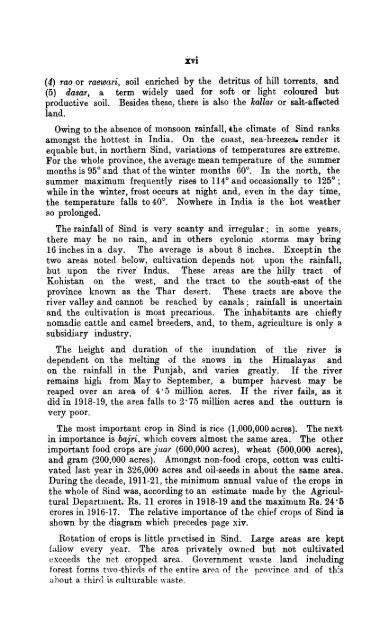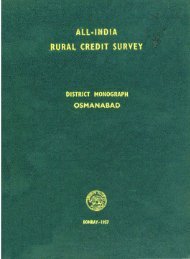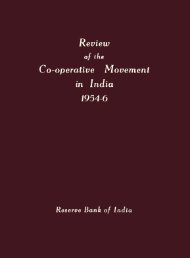Title : Royal Commission on Agriculture in India - Reserve Bank of ...
Title : Royal Commission on Agriculture in India - Reserve Bank of ...
Title : Royal Commission on Agriculture in India - Reserve Bank of ...
Create successful ePaper yourself
Turn your PDF publications into a flip-book with our unique Google optimized e-Paper software.
xvi<br />
(4) rao or raewari, soil enriched by the detritus <strong>of</strong> hill torrents, and<br />
(5) dasar, a term widely used for s<strong>of</strong>t or light coloured but<br />
productive soil. Besides these, there is also the kalla1' or salt-affected<br />
land.<br />
Ow<strong>in</strong>g to the absence <strong>of</strong> m<strong>on</strong>so<strong>on</strong> ra<strong>in</strong>fall, the climate <strong>of</strong> S<strong>in</strong>d ranks<br />
am<strong>on</strong>gst the hottest <strong>in</strong> <strong>India</strong>. On the coast, sea-breezes. render it<br />
equable but, <strong>in</strong> northern S<strong>in</strong>d, variati<strong>on</strong>s <strong>of</strong> temperatures are extreme.<br />
For the whole prov<strong>in</strong>ce, the average mean temperature <strong>of</strong> the summer<br />
m<strong>on</strong>ths is 95° and that <strong>of</strong> the w<strong>in</strong>ter m<strong>on</strong>ths 60°. In the north, the<br />
summer maximum frequently rises to 114.0 and occasi<strong>on</strong>ally to 125 0 ;<br />
while <strong>in</strong> the w<strong>in</strong>ter, frost occurs at night and, even <strong>in</strong> the day time,<br />
the temperature falls to 40°. Nowhere <strong>in</strong> <strong>India</strong> is the hot weather<br />
so prol<strong>on</strong>ged.<br />
The ra<strong>in</strong>fall <strong>of</strong> S<strong>in</strong>d is very scanty and irregular; <strong>in</strong> some years,<br />
there may be no ra<strong>in</strong>, and <strong>in</strong> others cycl<strong>on</strong>ic storms may br<strong>in</strong>g<br />
16 <strong>in</strong>ches <strong>in</strong> a day. The average is about 8 <strong>in</strong>ches. Except<strong>in</strong> the<br />
two areas noted below, cultivati<strong>on</strong> depends not up<strong>on</strong> the ra<strong>in</strong>fall,<br />
but up<strong>on</strong> the river· Indus. These areas are the hilly tract <strong>of</strong><br />
Kohistan <strong>on</strong> the west, and the tract to the south-east <strong>of</strong> the<br />
prov<strong>in</strong>ce known as the Thar deRert. These tracts are above the<br />
ri ver valley and cannot be reached by canals; ra<strong>in</strong>fall is uncerta<strong>in</strong><br />
and the cultivati<strong>on</strong> is most precarious. The <strong>in</strong>habitants are chiefly<br />
nomadic cattle and camel breeders, and, t.o them, agriculture is <strong>on</strong>ly a<br />
subsidiary <strong>in</strong>dustry.<br />
The height and durati<strong>on</strong> <strong>of</strong> the <strong>in</strong>undati<strong>on</strong> <strong>of</strong> the river is<br />
dependent <strong>on</strong> the melt<strong>in</strong>g vf the snows <strong>in</strong> the Himalayas and<br />
<strong>on</strong> the ra<strong>in</strong>fall <strong>in</strong> the Punjab, and varies greatly. If the river<br />
rema<strong>in</strong>s high from May to September, a bumper harvest may be<br />
reaped over an area <strong>of</strong> 4')) milli<strong>on</strong> acres. If the river fails, as it<br />
did <strong>in</strong> 1918-19, the area falls to 2'75 milli<strong>on</strong> acres and the outturn is<br />
very poor.<br />
The most important crop <strong>in</strong> S<strong>in</strong>d is rice (1,000,000 acres). The next<br />
<strong>in</strong> importance is bajri, which covers almost the same area. The other<br />
important food crops are jua1" (600,000 acres), wheat (500,000 acres),<br />
and gram (200,000 acres). Am<strong>on</strong>gst n<strong>on</strong>-food crops, cott<strong>on</strong> was cultivated<br />
last year <strong>in</strong> 326,000 acres and oil-seeds <strong>in</strong> about the same area.<br />
Dur<strong>in</strong>g the decade, 1911-21, the m<strong>in</strong>imum annual value <strong>of</strong> the crops <strong>in</strong><br />
the whole <strong>of</strong> S<strong>in</strong>d was, accord<strong>in</strong>g to an estimate made by the Agricultural<br />
Department. Rs. 11 crores <strong>in</strong> 1918-19 and the maximum Rs. 24'5<br />
crores <strong>in</strong> 1916-17. The relative importance <strong>of</strong> the chief ('ropR <strong>of</strong> S<strong>in</strong>d is<br />
shown by the diagram which precedes page xiv.<br />
Rotati<strong>on</strong> <strong>of</strong> crops is little pntctised <strong>in</strong> S<strong>in</strong>d. Large areas are kept<br />
fallow every year. The area privately owned but not cultivated<br />
exceeds the net cropped area. Government waste land <strong>in</strong>clud<strong>in</strong>g<br />
forest forms two-thirds <strong>of</strong> the entire arf':t <strong>of</strong> thr prov<strong>in</strong>ce and <strong>of</strong> th:s<br />
ahout a thircl iR cultnrable \\"llste.




